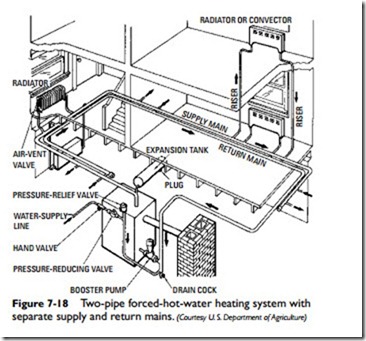Forced-Hot-Water Heating Systems
Water as a medium for transmitting heat to radiators and other heat-emitting units gives up only sensible heat, as distinguished from steam systems, which heat principally by the latent heat of evaporation. The result is that the temperature of the heat-emitting units of a steam system is relatively high as compared with hot water. In a hot-water system, latent heat is not given off; hence more radiating surface is needed to obtain equal heating effect.
Because hot water is heavier than steam and does not rise nearly as quickly, some means must be used to accelerate the rate of flow. This is done to increase the heating capacity of the heat-emitting units, make the system more responsive to load conditions, and allow the use of smaller pipes.
Numerous methods have been introduced to accelerate the circulation of hot water. The most commonly used methods have been based on the following techniques:
1. Using radiators with nipples along both the upper and lower portion of each radiator section.
2. Introducing high pressures to gain greater temperature differences.
3. Superheating a part or all of the circulating water as it passes through the boiler and condensing the steam thus formed by mixing it with a portion of the cold circulating water of the return main.
4. Introducing steam or air into the main riser near the top of the system.
5. Forcing by pumps.
6. Combining pumps and local boosters.
The last two methods (pumps or a combination of pumps and local boosters) are generally the ones used in most modern forced- hot-water (hydronic) heating systems. (See Figure 7-18.)
